A Method for Developing a Digital Terrain Model of the Coastal Zone Based on Topobathymetric Data from Remote Sensors
Abstract
1. Introduction
2. Materials and Methods
2.1. Measurement Location
2.2. Measurement Equipment
2.3. Realisation of Bathymetric and Topographic Measurements
2.3.1. Measurement Campaign Conducted on 29 September 2023
2.3.2. Measurement Campaign Conducted on 7 November 2023
2.4. Data Processing
- A total of 280 bathymetric points measured with the use of a GNSS RTK receiver;
- A total of 844 bathymetric points recorded using an SBES;
- A total of 119,462 bathymetric points generated with the use of the “Depth Prediction” method;
- A total of 322,604 topographic points generated using the SfM method.
3. Results
- σ—population standard deviation;
- N—number of depths in the population;
- xi—each depth error value from the population;
- μ—population mean.
- TVU—total vertical uncertainty at a confidence level of 95%.
- TVUmax(d)—maximum depth error at a confidence level of 95%;
- a—depth-independent component of measurement error;
- b—coefficient representing the depth-dependent component of measurement error;
- d—waterbody depth.
4. Discussion
5. Conclusions
Author Contributions
Funding
Data Availability Statement
Conflicts of Interest
References
- Herbert, T.; Ogochukwu, N.I.; John, F.A. Bathymetric Mapping for Safe Navigation: A Case Study of Part of Lagos Lagoon. Afr. Sch. J. Environ. Des. Constr. Mgt. (AJECM) 2019, 14, 1–13. [Google Scholar]
- Jaud, M.; Delsol, S.; Urbina-Barreto, I.; Augereau, E.; Cordier, E.; Guilhaumon, F.; Le Dantec, N.; Floc’h, F.; Delacourt, C. Low-tech and Low-cost System for High-resolution Underwater RTK Photogrammetry in Coastal Shallow Waters. Remote Sens. 2023, 16, 20. [Google Scholar] [CrossRef]
- Specht, C.; Lewicka, O.; Specht, M.; Zblewski, S. Impact of Hydrotechnical Structures on Forming the Tombolo Oceanographic Phenomenon in Kołobrzeg and Sopot. TransNav Int. J. Mar. Navig. Saf. Sea Transp. 2021, 15, 687–694. [Google Scholar] [CrossRef]
- Specht, M.; Specht, C.; Szafran, M.; Makar, A.; Dąbrowski, P.; Lasota, H.; Cywiński, P. The Use of USV to Develop Navigational and Bathymetric Charts of Yacht Ports on the Example of National Sailing Centre in Gdańsk. Remote Sens. 2020, 12, 2585. [Google Scholar] [CrossRef]
- Wlodarczyk-Sielicka, M.; Stateczny, A. Clustering Bathymetric Data for Electronic Navigational Charts. J. Navig. 2016, 69, 1143–1153. [Google Scholar] [CrossRef]
- Arseni, M.; Voiculescu, M.; Georgescu, L.P.; Iticescu, C.; Rosu, A. Testing Different Interpolation Methods Based on Single Beam Echosounder River Surveying. Case Study: Siret River. ISPRS Int. J. Geo-Inf. 2019, 8, 507. [Google Scholar] [CrossRef]
- Wlodarczyk-Sielicka, M.; Stateczny, A. Comparison of Selected Reduction Methods of Bathymetric Data Obtained by Multibeam Echosounder. In Proceedings of the 2016 Baltic Geodetic Congress (BGC 2016), Gdańsk, Poland, 2–4 June 2016. [Google Scholar]
- Gao, J. Bathymetric Mapping by Means of Remote Sensing: Methods, Accuracy and Limitations. Prog. Phys. Geogr. 2009, 33, 103–116. [Google Scholar] [CrossRef]
- Grządziel, A. Method of Time Estimation for the Bathymetric Surveys Conducted with a Multi-Beam Echosounder System. Appl. Sci. 2023, 13, 10139. [Google Scholar] [CrossRef]
- Agrafiotis, P.; Skarlatos, D.; Georgopoulos, A.; Karantzalos, K. Shallow Water Bathymetry Mapping from UAV Imagery Based on Machine Learning. Int. Arch. Photogramm. Remote Sens. Spat. Inf. Sci. 2019, 42, 9–16. [Google Scholar] [CrossRef]
- Brodie, K.L.; Bruder, B.L.; Slocum, R.K.; Spore, N.J. Simultaneous Mapping of Coastal Topography and Bathymetry from a Lightweight Multicamera UAS. IEEE Trans. Geosci. Remote Sens. 2019, 57, 6844–6864. [Google Scholar] [CrossRef]
- Del Savio, A.A.; Luna Torres, A.; Vergara Olivera, M.A.; Llimpe Rojas, S.R.; Urday Ibarra, G.T.; Neckel, A. Using UAVs and Photogrammetry in Bathymetric Surveys in Shallow Waters. Appl. Sci. 2023, 13, 3420. [Google Scholar] [CrossRef]
- He, J.; Lin, J.; Ma, M.; Liao, X. Mapping Topo-bathymetry of Transparent Tufa Lakes Using UAV-based Photogrammetry and RGB Imagery. Geomorphology 2021, 389, 107832. [Google Scholar] [CrossRef]
- Thomasberger, A.; Nielsen, M.M. UAV-based Subsurface Data Collection Using a Low-tech Ground-truthing Payload System Enhances Shallow-water Monitoring. Drones 2023, 7, 647. [Google Scholar] [CrossRef]
- Rossi, L.; Mammi, I.; Pelliccia, F. UAV-derived Multispectral Bathymetry. Remote Sens. 2020, 12, 3897. [Google Scholar] [CrossRef]
- Taddia, Y.; Russo, P.; Lovo, S.; Pellegrinelli, A. Multispectral UAV Monitoring of Submerged Seaweed in Shallow Water. Appl. Geomat. 2020, 12, 19–34. [Google Scholar] [CrossRef]
- Bagheri, O.; Ghodsian, M.; Saadatseresht, M. Reach Scale Application of UAV + SfM Method in Shallow Rivers Hyperspatial Bathymetry. Int. Arch. Photogramm. Remote Sens. Spat. Inf. Sci. 2015, 40, 77–81. [Google Scholar] [CrossRef]
- Eltner, A.; Sofia, G. Structure from Motion Photogrammetric Technique. In Developments in Earth Surface Processes; Tarolli, P., Mudd, S.M., Eds.; Elsevier: Amsterdam, The Netherlands, 2020; Chapter 1; Volume 23, pp. 1–24. [Google Scholar]
- Hänsel, P.; Schindewolf, M.; Eltner, A.; Kaiser, A.; Schmidt, J. Feasibility of High-resolution Soil Erosion Measurements by Means of Rainfall Simulations and SfM Photogrammetry. Hydrology 2016, 3, 38. [Google Scholar] [CrossRef]
- Specht, M.; Wiśniewska, M.; Stateczny, A.; Specht, C.; Szostak, B.; Lewicka, O.; Stateczny, M.; Widźgowski, S.; Halicki, A. Analysis of Methods for Determining Shallow Waterbody Depths Based on Images Taken by Unmanned Aerial Vehicles. Sensors 2022, 22, 1844. [Google Scholar] [CrossRef]
- Szostak, B.; Specht, M.; Burdziakowski, P.; Stateczny, A.; Specht, C.; Lewicka, O. Methodology for Performing Bathymetric Measurements of Shallow Waterbodies Using an UAV, and their Processing Based on the SVR Algorithm. Measurement 2023, 223, 113720. [Google Scholar] [CrossRef]
- Specht, M.; Stateczny, A.; Specht, C.; Widźgowski, S.; Lewicka, O.; Wiśniewska, M. Concept of an Innovative Autonomous Unmanned System for Bathymetric Monitoring of Shallow Waterbodies (INNOBAT System). Energies 2021, 14, 5370. [Google Scholar] [CrossRef]
- Specht, M.; Szostak, B.; Lewicka, O.; Stateczny, A.; Specht, C. Method for Determining of Shallow Water Depths Based on Data Recorded by UAV/USV Vehicles and Processed Using the SVR Algorithm. Measurement 2023, 221, 113437. [Google Scholar] [CrossRef]
- IHO. IHO Standards for Hydrographic Surveys, 6.1.0 ed.; Special Publication No. 44; IHO: Monaco, Monaco, 2022. [Google Scholar]
- Lewicka, O. Method for Accuracy Assessment of Topo-bathymetric Surface Models Based on Geospatial Data Recorded by UAV and USV Vehicles. Metrol. Meas. Syst. 2023, 30, 461–480. [Google Scholar] [CrossRef]
- Ruan, X.; Guo, M.; Zhan, Z. A Regional Digital Bathymetric Model Fusion Method Based on Topographic Slope: A Case Study of the South China Sea and Surrounding Waters. Heliyon 2024, 10, e26644. [Google Scholar] [CrossRef]
- Specht, O. Multi-sensor Integration of Hydroacoustic and Optoelectronic Data Acquired from UAV and USV Vehicles on the Inland Waterbody. TransNav Int. J. Mar. Navig. Saf. Sea Transp. 2023, 17, 791–798. [Google Scholar] [CrossRef]
- Włodarczyk-Sielicka, M.; Bodus-Olkowska, I.; Łącka, M. The Process of Modelling the Elevation Surface of a Coastal Area Using the Fusion of Spatial Data from Different Sensors. Oceanologia 2022, 64, 22–34. [Google Scholar] [CrossRef]
- Specht, O. Land and Seabed Surface Modelling in the Coastal Zone Using UAV/USV-based Data Integration. Sensors 2023, 23, 8020. [Google Scholar] [CrossRef] [PubMed]
- Stateczny, A. The Neural Method of Sea Bottom Shape Modelling for the Spatial Maritime Information System. In Maritime Engineering and Ports II; Brebbia, C.A., Olivella, J., Eds.; WIT Press: Southampton, UK, 2000; Volume 51, pp. 251–259. [Google Scholar]
- Oladosu, S.O.; Ehigiator-Irughe, R.; Aigbe, J.E. Seamless Topo-bathymetric Surveys of Maiyegun Estate Waterfront Lagos State, Nigeria. Niger. J. Technol. 2022, 41, 377–384. [Google Scholar] [CrossRef]
- Gesch, D.; Wilson, R. Development of a Seamless Multisource Topographic/Bathymetric Elevation Model of Tampa Bay. Mar. Technol. Soc. J. 2001, 35, 58–64. [Google Scholar] [CrossRef][Green Version]
- Bernstein, D.J.; Freeman, C.W.; Sumners, B.W.; Mitasova, H. Modern Techniques for Improved Topo/Bathy Elevation Modeling of Tidal Inlets. In Proceedings of the U.S. Hydro 2011 Conference, Tampa, FL, USA, 25–28 April 2011. [Google Scholar]
- Yoon, S.-J.; Kim, T. Fast UAV Image Mosaicking by a Triangulated Irregular Network of Bucketed Tiepoints. Remote Sens. 2023, 15, 5782. [Google Scholar] [CrossRef]
- Janas, U.; Kendzierska, H.; Dąbrowska, A.H.; Dziubińska, A. Non-indigenous Bivalve—The Atlantic Rangia Rangia Cuneata—In the Wisła Śmiała River (Coastal Waters of the Gulf of Gdańsk, the Southern Baltic Sea). Oceanol. Hydrobiol. Stud. 2014, 43, 427–430. [Google Scholar] [CrossRef]
- Discovery Tourism. Gdańsk Beach “Ujście Wisły”. Available online: https://odtur.pl/atrakcje/gdansk-plaza-gdansk-ujscie-wisly-53694.html (accessed on 3 December 2024). (In Polish).
- Gdańsk City Council. Resolution No. VII/65/11 of the Gdańsk City Council of 17 February 2011 on the Establishment of the “Zielone Wyspy” Ecological Site; Gdańsk City Council: Gdańsk, Poland, 2011. (In Polish) [Google Scholar]
- Soto-Marquez, E.; Caverlotti-Silva, M. Reduced Equations for K UTM Scale Factor and GNSS Usage in Chilean Cadastral Environments. J. Geospat. Surv. 2024, 4, 1–11. [Google Scholar] [CrossRef]
- EchoLogger. Single Frequency Echosounder (Shallow). Available online: https://www.echologger.com/products/single-frequency-echosounder-shallow (accessed on 3 December 2024).
- Trimble. Trimble R10 GNSS Receiver User Guide. Available online: https://receiverhelp.trimble.com/r10-gnss/R10%20UserGuide.pdf (accessed on 3 December 2024).
- Harley, M.D.; Turner, I.L.; Short, A.D.; Ranasinghe, R. Assessment and Integration of Conventional, RTK-GPS and Image-derived Beach Survey Methods for Daily to Decadal Coastal Monitoring. Coast. Eng. 2011, 58, 194–205. [Google Scholar] [CrossRef]
- Nayak, B.S.; Naik, K.; Ojjela, O.; Pal, S. GPS Receiver Simplification for Low cost Applications and Multipath Mitigation Analysis on SDR based Re Configurable Software Receiver. Def. Sci. J. 2023, 73, 699–711. [Google Scholar] [CrossRef]
- Aurelia Aerospace. Aurelia X8 Standard. Available online: https://aurelia-aerospace.com/product/aurelia-x8-standard/ (accessed on 3 December 2024).
- Sony. ILCE-6500. Available online: https://www.sony.com/electronics/support/e-mount-body-ilce-6000-series/ilce-6500/specifications (accessed on 3 December 2024).
- Sony Asia Pacific. E 35mm F1.8 OSS. Available online: https://www.sony-asia.com/electronics/camera-lenses/sel35f18#product_details_default (accessed on 3 December 2024).
- Bula, J.; Derron, M.-H.; Mariethoz, G. Dense Point Cloud Acquisition with a Low-cost Velodyne VLP-16. Geosci. Instrum. Methods Data Syst. 2020, 9, 385–396. [Google Scholar] [CrossRef]
- SBG Systems. Ellipse-D. Available online: https://www.sbg-systems.com/products/ellipse-series/#ellipse-d_rtk_gnss_ins (accessed on 3 December 2024).
- Chan, T.O.; Lichti, D.D.; Roesler, G.; Cosandier, D.; Al-Durgham, K. Range Scale-factor Calibration of the Velodyne VLP-16 Lidar System for Position Tracking Applications. In Proceedings of the 11th International Conference on Mobile Mapping Technology (MMT 2019), Shenzhen, China, 6–8 May 2019. [Google Scholar]
- Hong, N.; Hilfiker, J.N. Mueller Matrix Ellipsometry Study of a Circular Polarizing Filter. J. Vac. Sci. Technol. B 2020, 38, 014012. [Google Scholar] [CrossRef]
- Specht, M. Methodology for Performing Bathymetric and Photogrammetric Measurements Using UAV and USV Vehicles in the Coastal Zone. Remote Sens. 2024, 16, 3328. [Google Scholar] [CrossRef]
- Ferreira, I.O.; Santos, A.d.P.d.; Oliveira, J.C.d.; Medeiros, N.d.G.; Emiliano, P.C. Robust Methodology for Detection of Spikes in Multibeam Echo Sounder Data. Bol. Ciênc. Geod. 2019, 25, e2019014. [Google Scholar] [CrossRef]
- Condorelli, F.; Rinaudo, F.; Salvadore, F.; Tagliaventi, S. A Match-moving Method Combining AI and SFM Algorithms in Historical Film Footage. Int. Arch. Photogramm. Remote Sens. Spat. Inf. Sci. 2020, 43, 813–820. [Google Scholar] [CrossRef]
- Zhen, W.; Hu, Y.; Yu, H.; Scherer, S. LiDAR-enhanced Structure-from-Motion. In Proceedings of the 2020 IEEE International Conference on Robotics and Automation (ICRA 2020), Paris, France, 31 May–31 August 2020. [Google Scholar]
- Chandrashekar, A.; Papadakis, J.; Willis, A.; Gantert, J. Structure-from-Motion and RGBD Depth Fusion. In Proceedings of the IEEE SoutheastCon 2018, St. Petersburg, FL, USA, 19–22 April 2018. [Google Scholar]
- Reuter, H.I.; Hengl, T.; Gessler, P.; Soille, P. Preparation of DEMs for Geomorphometric Analysis. In Developments in Soil Organic Matter; Elsevier: Amsterdam, The Netherlands, 2009; Volume 33, pp. 87–120. [Google Scholar]
- Polidori, L.; El Hage, M. Digital Elevation Model Quality Assessment Methods: A Critical Review. Remote Sens. 2020, 12, 3522. [Google Scholar] [CrossRef]
- Graf, L.; Moreno-de-las-Heras, M.; Ruiz, M.; Calsamiglia, A.; García-Comendador, J.; Fortesa, J.; López-Tarazón, J.A.; Estrany, J. Accuracy Assessment of Digital Terrain Model Dataset Sources for Hydrogeomorphological Modelling in Small Mediterranean Catchments. Remote Sens. 2018, 10, 2014. [Google Scholar] [CrossRef]
- Chu, H.-J.; Chen, R.-A.; Tseng, V.S.; Wang, C.-K. Identifying LiDAR Sample Uncertainty on Terrain Features from DEM Simulation. Geomorphology 2014, 204, 325–333. [Google Scholar] [CrossRef]
- Podobnikar, T. Methods for Visual Quality Assessment of a Digital Terrain Model. SAPIENS 2009, 2, 1–10. [Google Scholar]
- Polidori, L.; El Hage, M.; Valeriano, M.D.M. Digital Elevation Model Validation with No Ground Control: Application to the Topodata DEM in Brazil. Bol. Ciências Geodésicas 2014, 20, 467–479. [Google Scholar] [CrossRef]
- Lubczonek, J.; Wlodarczyk-Sielicka, M.; Lacka, M.; Zaniewicz, G. Methodology for Developing a Combined Bathymetric and Topographic Surface Model Using Interpolation and Geodata Reduction Techniques. Remote Sens. 2021, 13, 4427. [Google Scholar] [CrossRef]
- Genchi, S.A.; Vitale, A.J.; Perillo, G.M.E.; Seitz, C.; Delrieux, C.A. Mapping Topobathymetry in a Shallow Tidal Environment Using Low-Cost Technology. Remote Sens. 2020, 12, 1394. [Google Scholar] [CrossRef]
- Mazza, D.; Parente, L.; Cifaldi, D.; Meo, A.; Senatore, M.R.; Guadagno, F.M.; Revellino, P. Quick Bathymetry Mapping of a Roman Archaeological Site Using RTK UAS-based Photogrammetry. Front. Earth Sci. 2023, 11, 1183982. [Google Scholar] [CrossRef]
- Barańczuk, J. The Statistical Relation/Coherence between Ice-Regimes of Lake Raduńskie Górne and Lake Ostrzyckie. Limnol. Rev. 2018, 18, 103–108. [Google Scholar] [CrossRef]
- Szumiejko, F.; Wdowikowski, M. IMGW-PIB Monitor as a Source of Information on Dangerous Meteorological and Hydrological Phenomena for Crisis Management Needs. Def. Sci. Q. Manag. Command. Fac. Natl. Def. Univ. Wars. 2016, 2, 209–226. (In Polish) [Google Scholar]
- Susetyo, D.B.; Syafiudin, M.F.; Prasetyo, Y. DTM Generation from TerraSAR-X Using TIN Algorithm in Papua Island, Indonesia. Int. Arch. Photogramm. Remote Sens. Spat. Inf. Sci. 2017, 42, 101–106. [Google Scholar] [CrossRef]
- Matori, A.N.; Hidzir, H. Low Cost DTM for Certain Engineering Purposes. In Proceedings of the Map Asia 2010 & ISG 2010 Conference, Kuala Lumpur, Malaysia, 26–28 July 2010. [Google Scholar]
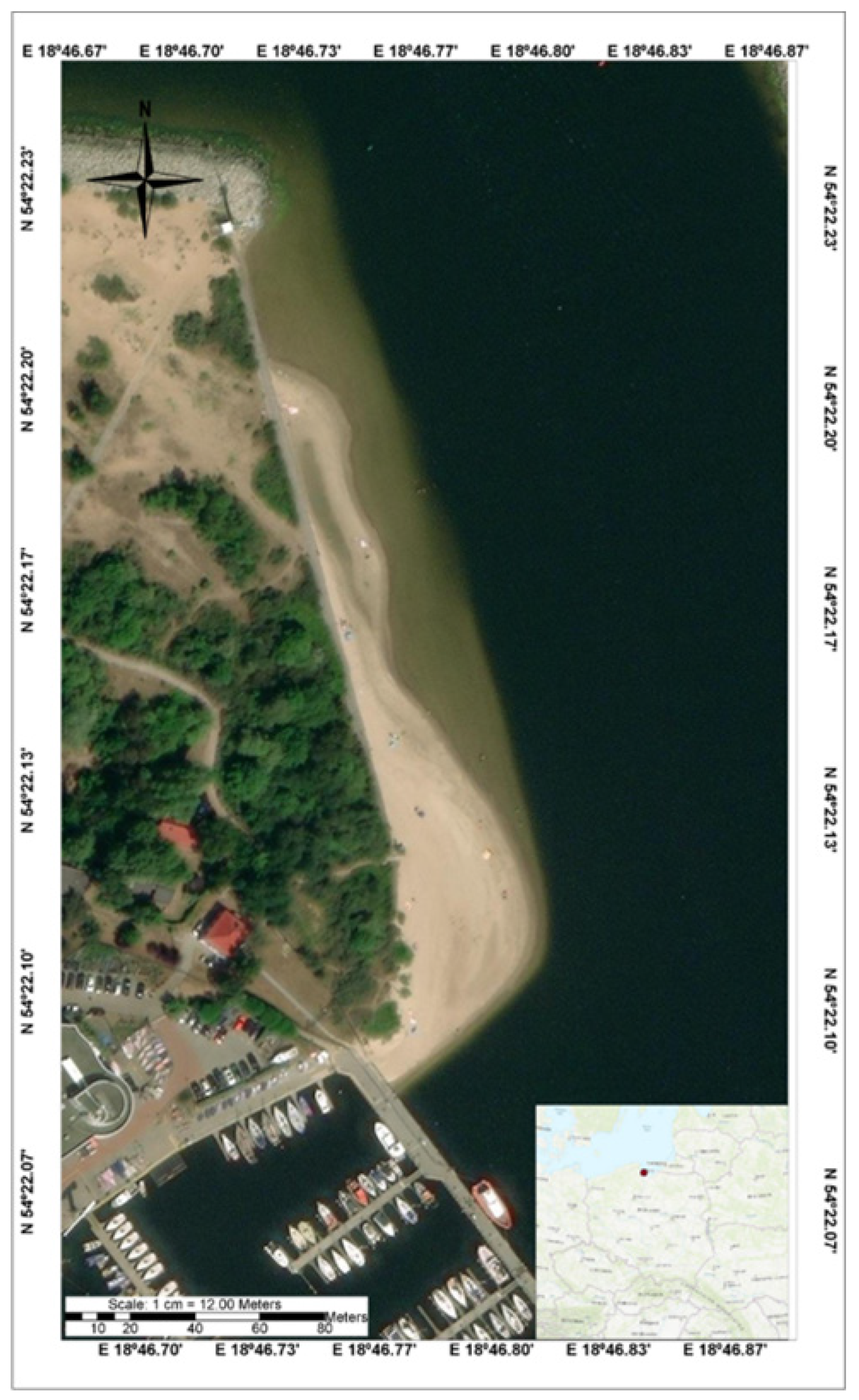


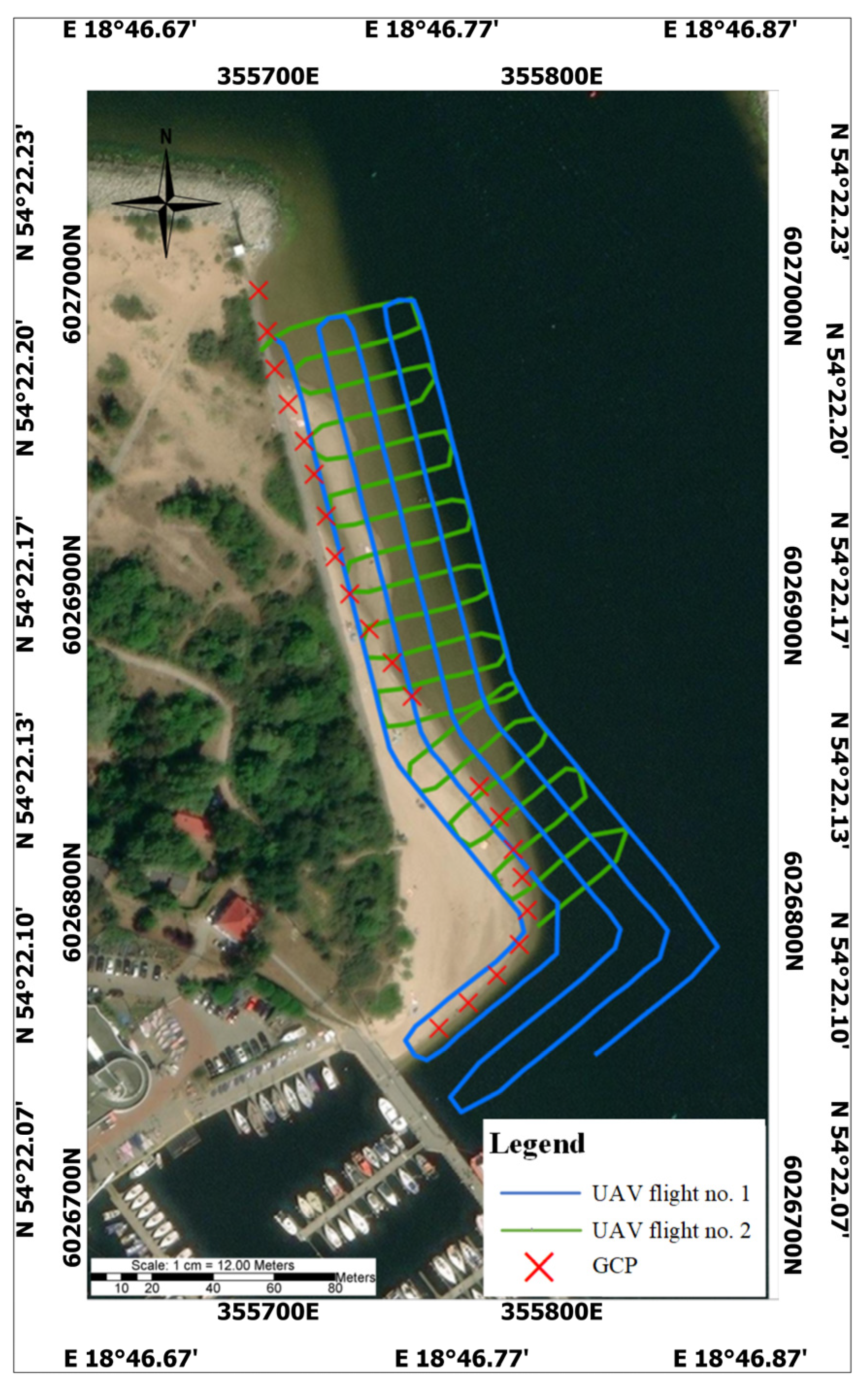
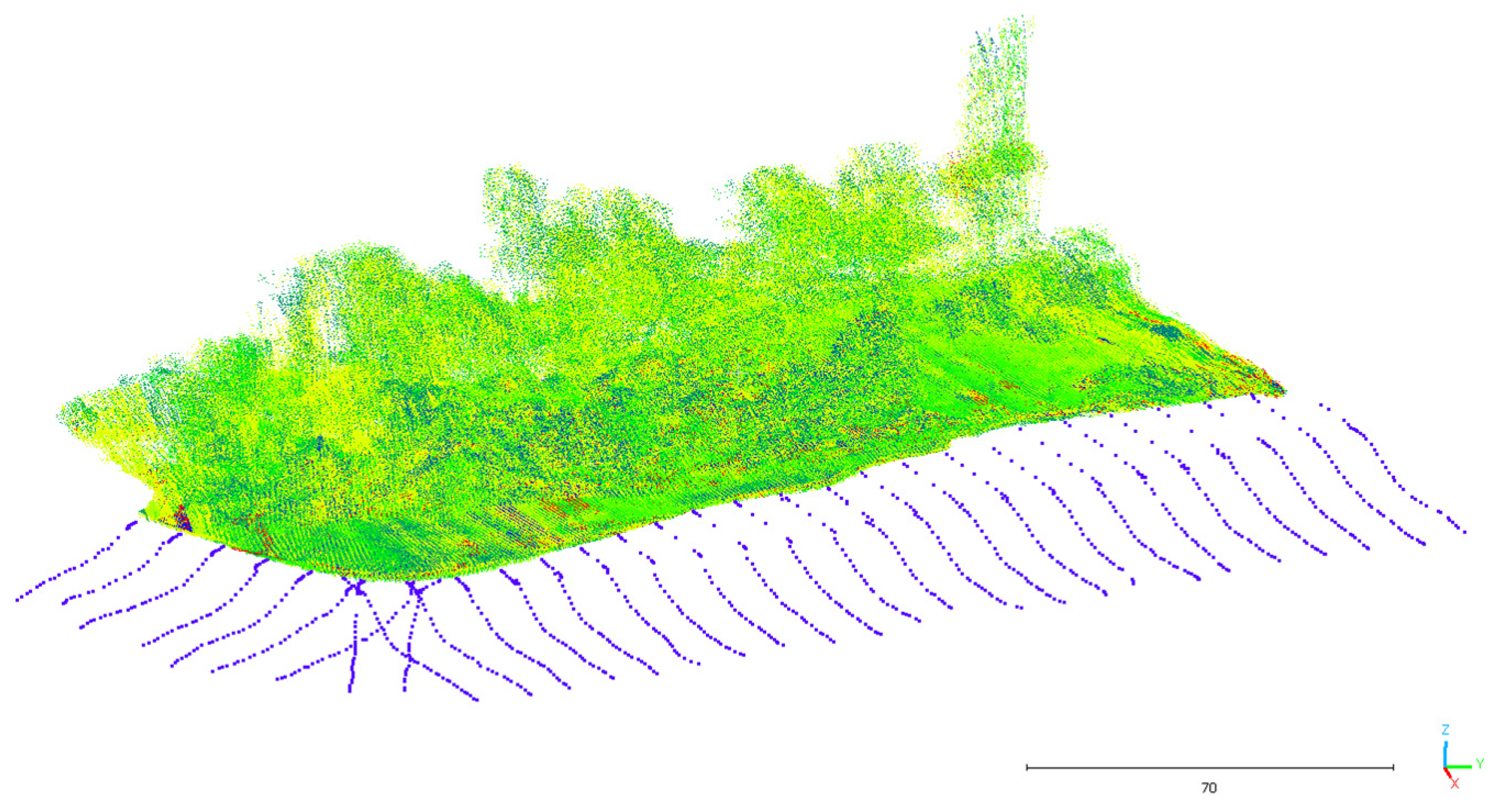

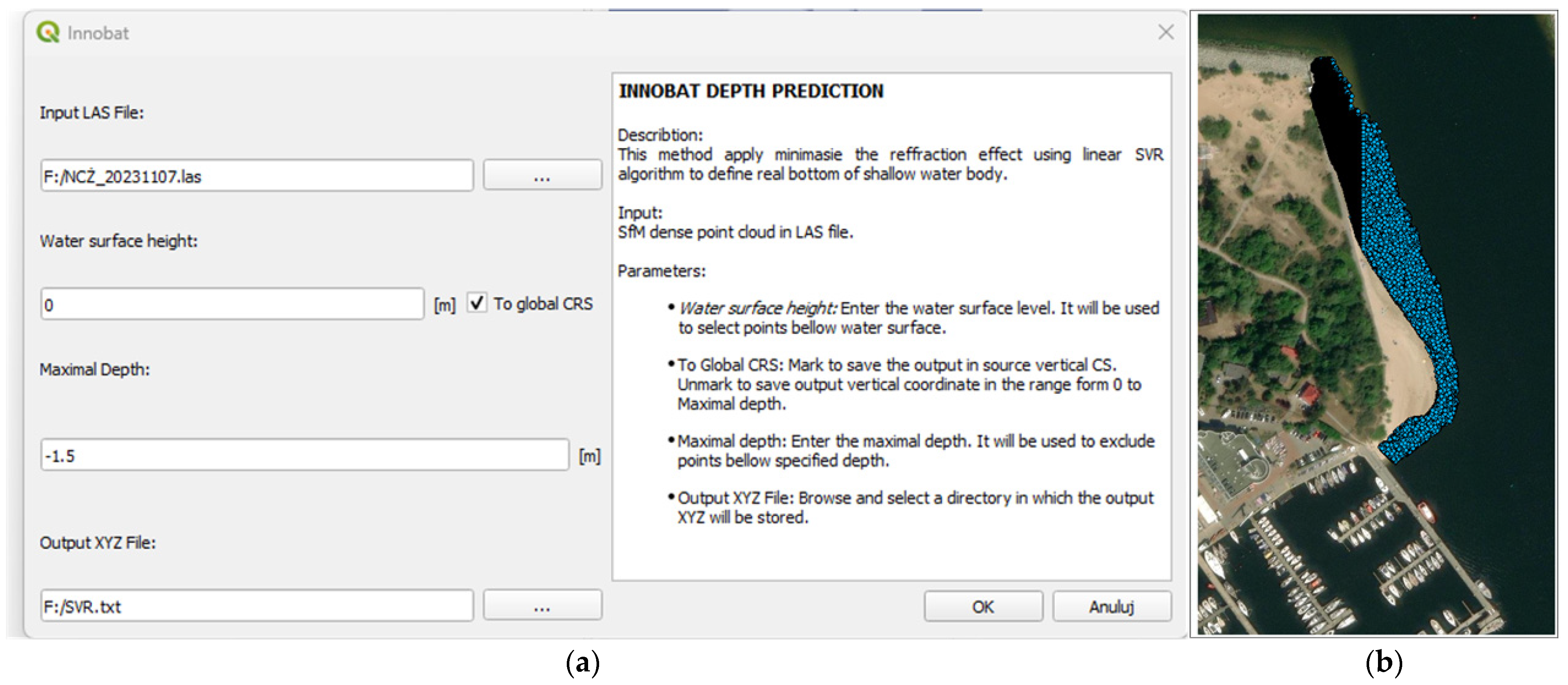
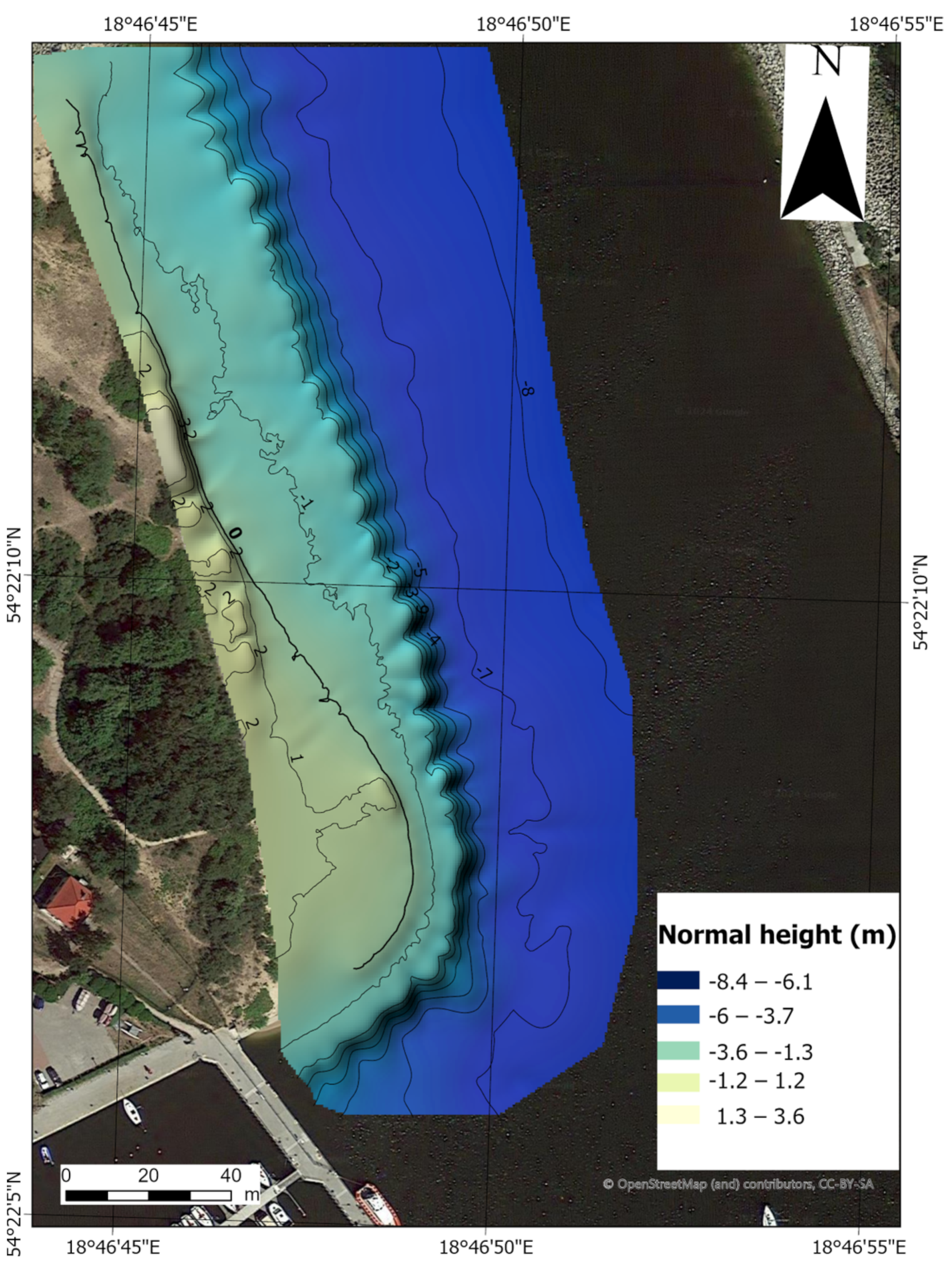
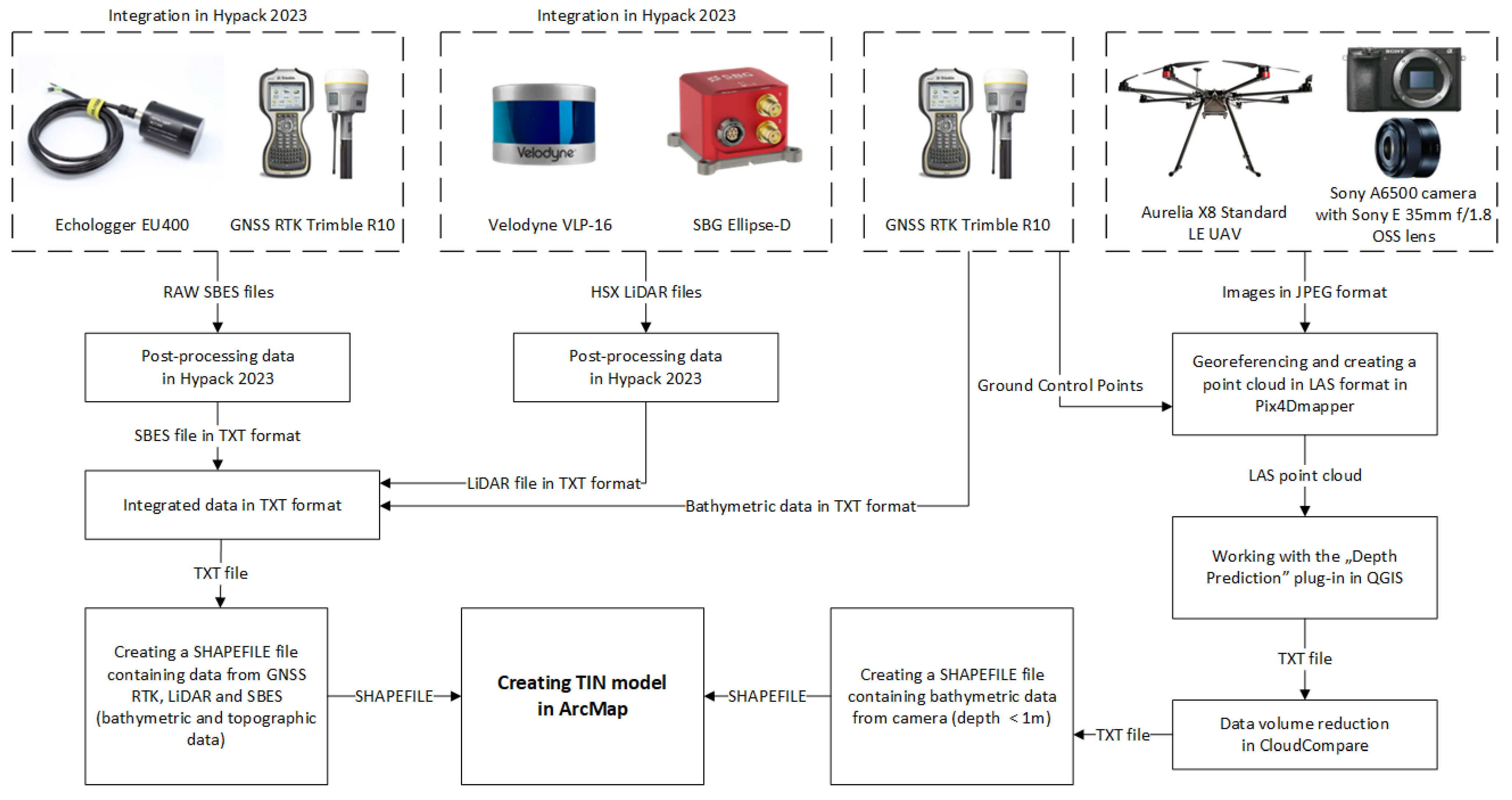
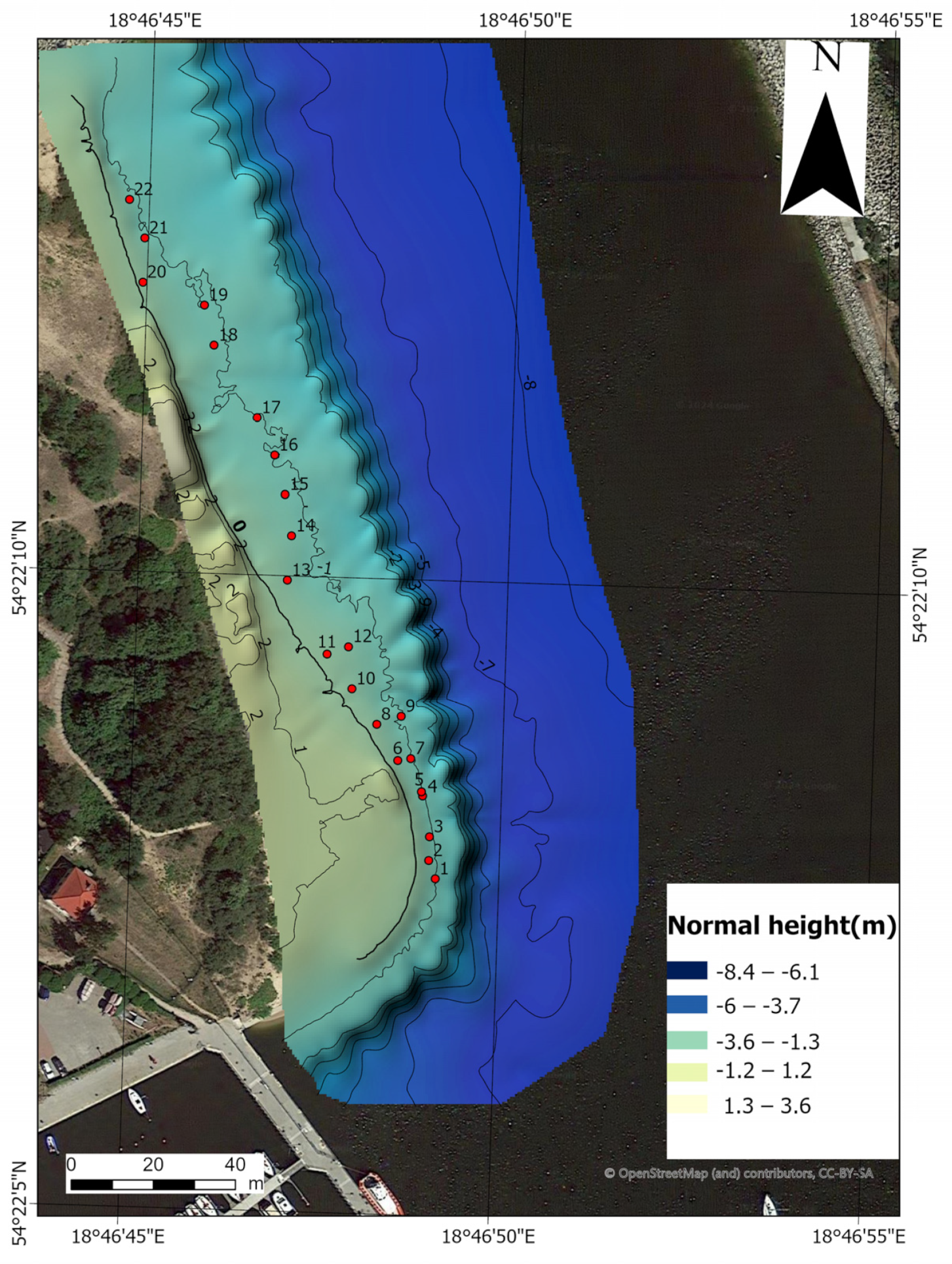
| Echologger EU400 SBES | GNSS RTK Trimble R10 | ||
|---|---|---|---|
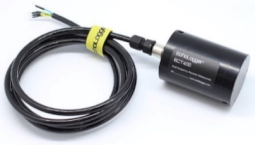 | 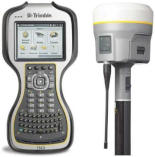 | ||
| Frequency | 450/200 kHz | Channels | 440 |
| Beamwidth | 5/10° | Satellite signals tracked simultaneously | GPS, GLONASS, BDS, Galileo and SBAS |
| Transmit pulse width | 10–200 μs (10 μs step) | Positioning rate | 1, 2, 5, 10 and 20 Hz |
| Range | 0.15–100 m | Horizontal positioning accuracy | RTK: ±8 mm + 1 ppm RMS |
| Repetition rate | max 10 Hz | DGPS: ±0.25 m + 1 ppm RMS | |
| Sampling rate | 100 kHz | Static mode: ±3 mm + 0.1 ppm RMS | |
| Water column resolution | ±7.5 mm | Vertical positioning accuracy | RTK: ±15 mm + 1 ppm RMS |
| Altimeter range resolution | 1 mm | DGPS: ±0.25 m + 1 ppm RMS | |
| Temperature resolution | 0.1 °C | Static mode: ±3.5 mm + 0.4 ppm RMS | |
| Aurelia X8 Standard LE UAV | Sony A6500 Camera with Sony E 35 mm f/1.8 OSS Lens | ||
|---|---|---|---|
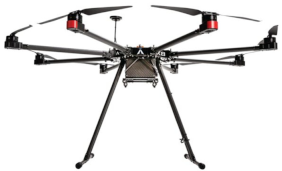 | 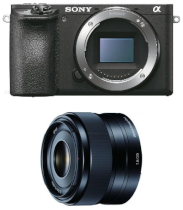 | ||
| Max flight time | 45 min. | Image sensor | Sensor type: APS-C type (23.5 × 15.6 mm), CMOS Aspect Ratio: 3:2 Number of pixels: 25 Mpx |
| UAV empty weight | 5.95 kg | ||
| UAV weight incl. batteries | 9.79 kg | ||
| UAV MTOW | 17.79 kg | Lens | Angle of view: 44° Focal length: 35 mm Aperture width: f/1.8–f/22 Sharpness: 0.3 m-∞ |
| Max flight speed | 56 km/h | ||
| Max wind resistance | 32 km/h | ||
| Operating temperature | –15 °C to 50 °C | ||
| Max service ceiling | 3000 m ASL | ISO range | 100–51,200 |
| Operating range | 2.4–5 km | Electronic shutter speed | 1/4000–30 s |
| Operating frequencies | 433 MHz, 915 MHz or 2.4 Ghz | Max image size | 6000 × 3376 (16:9) or 6000 × 4000 (3:2) |
| GPS receiver | u-blox NEO-M9N | Photo file format | JPEG, RAW |
| Compass | RM3100 | Data recording | Memory Stick Duo or SD memory card |
| Velodyne VLP-16 Lite LiDAR System | SBG Ellipse-D INS | ||
|---|---|---|---|
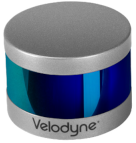 |  | ||
| Channels | 16 | Pitch/Roll accuracy | SP: 0.1° RMS RTK: 0.05° RMS PPK: 0.03° RMS |
| Measurement range | 100 m | ||
| Field of view (vertical) | –15° to 15° | Heading accuracy | Dual antenna 2 m: 0.2° RMS Single antenna: 0.2° RMS PPK: 0.1° RMS |
| Angular resolution (vertical) | 2° | ||
| Field of view (horizontal) | 360° | Velocity accuracy | 0.03 m/s RMS |
| Navigation accuracy | SP: 1.2 m RMS SBAS: 1 m RMS RTK/PPK: 1 cm + 1 ppm RMS | ||
| Angular resolution (horizontal) | 0.1–0.4° | ||
| Rotation rate | 5–20 Hz | Available data | Calibrated sensor data, delta angles and velocity, Euler angles, GNSS raw data, GPS data, heave, position, status, UTC time, velocity, etc. |
| Wavelength | 903 nm | ||
| LiDAR points generated per second | 300,000–600,000 | Aiding sensors | GNSS, odometer, RTCM |
| Output rate | 200/1000 Hz | ||
| Dimensions | 103 × 72 mm diameter × height | Dimensions | 46 × 45 × 32 mm |
| Weight | 590 g | Weight | 65 g |
| Isobath (m) | Distance Ranges from the Shoreline to Each Isobath (m) |
|---|---|
| 1 | 4–22 |
| 2 | 9–38 |
| 3 | 11–39 |
| 4 | 12–41 |
| 5 | 13–42 |
| 6 | 16–46 |
| 7 | 26–57 |
| 8 | 57–84 |
| Point Number | Observed Depth (m) | Predicted Depth (m) | xi (m) | μ (m) | (xi–μ)2 (m2) | σ (m) | TVU (m) |
|---|---|---|---|---|---|---|---|
| 1 | –0.202 | –0.390 | 0.188 | 0.078 | 0.012 | 0.127 | 0.248 |
| 2 | –0.100 | –0.320 | 0.220 | 0.020 | |||
| 3 | –0.229 | –0.350 | 0.121 | 0.002 | |||
| 4 | –0.413 | –0.420 | 0.007 | 0.005 | |||
| 5 | –0.650 | –0.460 | –0.190 | 0.072 | |||
| 6 | –0.213 | –0.170 | –0.043 | 0.015 | |||
| 7 | –0.680 | –0.700 | 0.020 | 0.003 | |||
| 8 | –0.217 | –0.180 | –0.037 | 0.013 | |||
| 9 | –0.710 | –0.800 | 0.090 | 0.000 | |||
| 10 | –0.205 | –0.160 | –0.045 | 0.015 | |||
| 11 | –0.180 | –0.310 | 0.130 | 0.003 | |||
| 12 | –0.271 | –0.390 | 0.119 | 0.002 | |||
| 13 | –0.205 | –0.270 | 0.065 | 0.000 | |||
| 14 | –0.232 | –0.450 | 0.218 | 0.020 | |||
| 15 | –0.714 | –0.500 | –0.214 | 0.085 | |||
| 16 | –0.225 | –0.410 | 0.185 | 0.012 | |||
| 17 | –0.229 | –0.370 | 0.141 | 0.004 | |||
| 18 | –0.158 | –0.360 | 0.202 | 0.015 | |||
| 19 | –0.129 | –0.340 | 0.211 | 0.018 | |||
| 20 | –0.139 | –0.100 | –0.039 | 0.014 | |||
| 21 | –0.231 | –0.370 | 0.139 | 0.004 | |||
| 22 | –0.329 | –0.550 | 0.221 | 0.021 |
Disclaimer/Publisher’s Note: The statements, opinions and data contained in all publications are solely those of the individual author(s) and contributor(s) and not of MDPI and/or the editor(s). MDPI and/or the editor(s) disclaim responsibility for any injury to people or property resulting from any ideas, methods, instructions or products referred to in the content. |
© 2024 by the authors. Licensee MDPI, Basel, Switzerland. This article is an open access article distributed under the terms and conditions of the Creative Commons Attribution (CC BY) license (https://creativecommons.org/licenses/by/4.0/).
Share and Cite
Specht, M.; Wiśniewska, M. A Method for Developing a Digital Terrain Model of the Coastal Zone Based on Topobathymetric Data from Remote Sensors. Remote Sens. 2024, 16, 4626. https://doi.org/10.3390/rs16244626
Specht M, Wiśniewska M. A Method for Developing a Digital Terrain Model of the Coastal Zone Based on Topobathymetric Data from Remote Sensors. Remote Sensing. 2024; 16(24):4626. https://doi.org/10.3390/rs16244626
Chicago/Turabian StyleSpecht, Mariusz, and Marta Wiśniewska. 2024. "A Method for Developing a Digital Terrain Model of the Coastal Zone Based on Topobathymetric Data from Remote Sensors" Remote Sensing 16, no. 24: 4626. https://doi.org/10.3390/rs16244626
APA StyleSpecht, M., & Wiśniewska, M. (2024). A Method for Developing a Digital Terrain Model of the Coastal Zone Based on Topobathymetric Data from Remote Sensors. Remote Sensing, 16(24), 4626. https://doi.org/10.3390/rs16244626







